ZnO Nanostructures with Antibacterial Properties Prepared by a Green Electrochemical-Thermal Approach
Abstract
:1. Introduction
2. Materials and Methods
2.1. Materials
2.2. Synthesis of ZnONSs
2.3. Morphological and Spectroscopic Characterizations
2.4. Antimicrobial Activity of ZnONSs
3. Results and Discussion
3.1. Electrochemical Production of ZnONSs
3.2. Morphological Characterization
3.3. FTIR and UV–Vis Characterizations
3.4. XPS Characterization
3.5. ζ-Potential Measurements
3.6. Agar Disk Diffusion Tests
4. Conclusions
Supplementary Materials
Author Contributions
Funding
Acknowledgments
Conflicts of Interest
References
- Özgür, Ü.; Alivov, Y.I.; Liu, C.; Teke, A.; Reshchikov, M.A.; Doğan, S.; Avrutin, V.; Cho, S.-J.; Morkoç, H. A comprehensive review of ZnO materials and devices. J. Appl. Phys. 2005, 98, 11. [Google Scholar] [CrossRef] [Green Version]
- Sportelli, M.C.; Picca, R.A.; Cioffi, N. Nano-Antimicrobials Based on Metals. In Novel Antimicrobial Agents and Strategies; Wiley-VCH Verlag GmbH & Co. KgaA: Weinheim, Germany, 2014; pp. 181–218. ISBN 978-3-527-67613-2. [Google Scholar]
- Ditaranto, N.; van der Werf, I.D.; Picca, R.A.; Sportelli, M.C.; Giannossa, L.C.; Bonerba, E.; Tantillo, G.; Sabbatini, L. Characterization and behaviour of ZnO-based nanocomposites designed for the control of biodeterioration of patrimonial stoneworks. New J. Chem. 2015, 39, 6836–6843. [Google Scholar] [CrossRef]
- van der Werf, I.D.; Ditaranto, N.; Picca, R.A.; Sportelli, M.C.; Sabbatini, L. Development of a novel conservation treatment of stone monuments with bioactive nanocomposites. Herit. Sci. 2015, 3, 29. [Google Scholar] [CrossRef]
- Ditaranto, N.; Picca, R.A.; Sportelli, M.C.; Sabbatini, L.; Cioffi, N. Surface characterization of textiles modified by copper and zinc oxide nano-antimicrobials. Surf. Interface Anal. 2016, 48, 505–508. [Google Scholar] [CrossRef]
- Sportelli, M.C.; Valentini, M.; Picca, R.A.; Milella, A.; Nacci, A.; Valentini, A.; Cioffi, N. New Insights in the Ion Beam Sputtering Deposition of ZnO-Fluoropolymer Nanocomposites. Appl. Sci. 2018, 8, 77. [Google Scholar] [CrossRef] [Green Version]
- Sportelli, M.C.; Nitti, M.A.; Valentini, M.; Picca, R.A.; Bonerba, E.; Sabbatini, L.; Tantillo, G.; Cioffi, N.; Valentini, A. Ion Beam Sputtering Deposition and Characterization of ZnO-Fluoropolymer Nano-Antimicrobials. Sci. Adv. Mat. 2014, 6, 1019–1025. [Google Scholar] [CrossRef]
- He, X.X.; Li, H.Q.; Gu, J.B.; Wu, S.B.; Cao, B. The Properties of ZnO Thin Films Fabricated by Ion Beam Sputtering and RF Magnetron Sputtering; Shen, W., Chu, J., Eds.; SPIE digital library: Bellingham, WA, USA, 2008; p. 69842T. [Google Scholar]
- Amizam, S.; Abdullah, N.; Rafaie, H.A.; Rusop, M.; Rusop, M.; Subban, R.Y.; Kamarulzaman, N.; Wui, W.T. SEM and XRD Characterization of ZnO Nanostructured Thin Films Prepared by Sol-Gel Method with Various Annealing Temperatures; AIP Publishing LLC: Mellville, NY, USA, 2010; pp. 37–41. [Google Scholar]
- Benramache, S.; Benhaoua, B.; Chabane, F.; Guettaf, A. A comparative study on the nanocrystalline ZnO thin films prepared by ultrasonic spray and sol-gel method. Optik Int. J. Light Electron Opt. 2013, 124, 3221–3224. [Google Scholar] [CrossRef]
- Ahmad, M.Z.; Sadek, A.Z.; Latham, K.; Kita, J.; Moos, R.; Wlodarski, W. Chemically synthesized one-dimensional zinc oxide nanorods for ethanol sensing. Sens. Actuators B Chem. 2013, 187, 295–300. [Google Scholar] [CrossRef]
- Sportelli, M.C.; Scarabino, S.; Picca, R.A.; Cioffi, N. Recent trends in the electrochemical synthesis of zinc oxide nano-colloids. In CRC Concise Encyclopedia of Nanotechnology; CRC Press, LLC: Boca Raton, FL, USA, 2015; pp. 1158–1172. ISBN 978-1-4665-8034-3. [Google Scholar]
- Izzi, M.; Sportelli, M.C.; Ditaranto, N.; Picca, R.A.; Innocenti, M.; Sabbatini, L.; Cioffi, N. Pros and Cons of Sacrificial Anode Electrolysis for the Preparation of Transition Metal Colloids: A Review. ChemElectroChem 2020, 7, 386–394. [Google Scholar] [CrossRef]
- Picca, R.A.; Sportelli, M.C.; Hötger, D.; Manoli, K.; Kranz, C.; Mizaikoff, B.; Torsi, L.; Cioffi, N. Electrosynthesis and characterization of ZnO nanoparticles as inorganic component in organic thin-film transistor active layers. Electrochim. Acta 2015, 178, 45–54. [Google Scholar] [CrossRef]
- Chandrappa, K.; Venkatesha, T.; Vathsala, K.; Shivakumara, C. A hybrid electrochemical–thermal method for the preparation of large ZnO nanoparticles. J. Nanoparticle Res. 2010, 12, 2667–2678. [Google Scholar] [CrossRef]
- Dierstein, A.; Natter, H.; Meyer, F.; Stephan, H.-O.; Kropf, C.; Hempelmann, R. Electrochemical deposition under oxidizing conditions (EDOC): A new synthesis for nanocrystalline metal oxides. Scr. Mater. 2001, 44, 2209–2212. [Google Scholar] [CrossRef]
- Starowicz, M.; Stypuła, B. Electrochemical Synthesis of ZnO Nanoparticles. Eur. J. Inorg. Chem. 2008, 2008, 869–872. [Google Scholar] [CrossRef]
- Starowicz, M.; Stypuła, B.; Banaś, J. Electrochemical synthesis of silver nanoparticles. Electrochem. Commun. 2006, 8, 227–230. [Google Scholar] [CrossRef]
- Dhayagude, A.C.; Nikam, S.V.; Kapoor, S.; Joshi, S.S. Effect of electrolytic media on the photophysical properties and photocatalytic activity of zinc oxide nanoparticles synthesized by simple electrochemical method. J. Mol. Liq. 2017, 232, 290–303. [Google Scholar] [CrossRef]
- Chandrappa, K.G.; Venkatesha, T.V. Electrochemical Synthesis and Photocatalytic Property of Zinc Oxide Nanoparticles. Nano-Micro Lett. 2012, 4, 14–24. [Google Scholar] [CrossRef] [Green Version]
- Sportelli, M.C.; Hötger, D.; Picca, R.A.; Manoli, K.; Kranz, C.; Mizaikoff, B.; Torsi, L.; Cioffi, N. Electrosynthesized Polystyrene Sulphonate-Capped Zinc Oxide Nanoparticles as Electrode Modifiers for Sensing Devices. In Proceedings of the Symposium K/RR—Synthesis, Characterization and Applications of Functional Materials—Thin Films and Nanostructures, San Francisco, CA, USA, 21–25 April 2014; Volume 1675. [Google Scholar]
- Picca, R.A.; Sportelli, M.C.; Lopetuso, R.; Cioffi, N. Electrosynthesis of ZnO nanomaterials in aqueous medium with CTAB cationic stabilizer. J. Sol-Gel Sci. Technol. 2017, 82, 338–345. [Google Scholar] [CrossRef]
- Sportelli, M.C.; Picca, R.A.; Cioffi, N. Recent advances in the synthesis and characterization of nano-antimicrobials. TrAC Trends Anal. Chem. 2016, 84, 131–138. [Google Scholar] [CrossRef]
- Kumar, R.; Umar, A.; Kumar, G.; Nalwa, H.S. Antimicrobial properties of ZnO nanomaterials: A review. Ceram. Int. 2017, 43, 3940–3961. [Google Scholar] [CrossRef]
- Sportelli, M.C.; Picca, R.A.; Manoli, K.; Re, M.; Pesce, E.; Tapfer, L.; Di Franco, C.; Cioffi, N.; Torsi, L. Surface analytical characterization of Streptavidin/poly(3–hexylthiophene) bilayers for bio-electronic applications. Appl. Surface Sci. 2017, 420, 313–322. [Google Scholar] [CrossRef]
- Picca, R.A.; Manoli, K.; Luciano, A.; Sportelli, M.C.; Palazzo, G.; Torsi, L.; Cioffi, N. Enhanced stability of organic field-effect transistor biosensors bearing electrosynthesized ZnO nanoparticles. Sens. Actuators B Chem. 2018, 274, 210–217. [Google Scholar] [CrossRef]
- Sarfraz, S.; Ali, S.; Khan, S.A.; Shah, K.H.; Amin, S.; Mujahid, M.; Jamil, S.; Janjua, M.R.S.A. Phase diagram and surface adsorption behavior of benzyl dimethyl hexadecyl ammonium bromide in a binary surfactant-water system. J. Mol. Liq. 2019, 285, 403–407. [Google Scholar] [CrossRef]
- Rahman, Q.I.; Ahmad, M.; Misra, S.K.; Lohani, M.B. Hexagonal ZnO nanorods assembled flowers for photocatalytic dye degradation: Growth, structural and optical properties. Superlattices Microstruct. 2013, 64, 495–506. [Google Scholar] [CrossRef]
- Sun, X.M.; Chen, X.; Deng, Z.X.; Li, Y.D. A CTAB-assisted hydrothermal orientation growth of ZnO nanorods. Mater. Chem. Phys. 2003, 78, 99–104. [Google Scholar] [CrossRef]
- Maiti, U.N.; Nandy, S.; Karan, S.; Mallik, B.; Chattopadhyay, K.K. Enhanced optical and field emission properties of CTAB-assisted hydrothermal grown ZnO nanorods. Appl. Surface Sci. 2008, 254, 7266–7271. [Google Scholar] [CrossRef]
- Hales, M.C.; Frost, R.L. Synthesis and vibrational spectroscopic characterisation of synthetic hydrozincite and smithsonite. Polyhedron 2007, 26, 4955–4962. [Google Scholar] [CrossRef] [Green Version]
- Coblentz Society Inc. NIST Standard Reference Data: Reference Infrared Spectra. Available online: https://webbook.nist.gov/chemistry/ (accessed on 10 December 2019).
- Dimakis, V.T.; Gavalas, V.G.; Chaniotakis, N.A. Polyelectrolyte-stabilized biosensors based on macroporous carbon electrode. Anal. Chim. Acta 2002, 467, 217–223. [Google Scholar] [CrossRef]
- Pudukudy, M.; Yaakob, Z. Facile Synthesis of Quasi Spherical ZnO Nanoparticles with Excellent Photocatalytic Activity|SpringerLink. J. Clust. Sci. 2015, 26, 1187–1201. [Google Scholar] [CrossRef]
- National Institute of Standards and Technology XPS Database. Available online: http://srdata.nist.gov/xps (accessed on 10 December 2019).
- Winiarski, J.; Tylus, W.; Winiarska, K.; Szczygieł, I.; Szczygieł, B. XPS and FT-IR Characterization of Selected Synthetic Corrosion Products of Zinc Expected in Neutral Environment Containing Chloride Ions. J. Spectrosc. 2018, 2018, 2079278. [Google Scholar] [CrossRef] [Green Version]
- Cocco, F.; Elsener, B.; Fantauzzi, M.; Atzei, D.; Rossi, A. Nanosized surface films on brass alloys by XPS and XAES. RSC Adv. 2016, 6, 31277–31289. [Google Scholar] [CrossRef]
- Deroubaix, G.; Marcus, P. X-ray photoelectron spectroscopy analysis of copper and zinc oxides and sulphides. Surface Interface Anal. 1992, 18, 39–46. [Google Scholar] [CrossRef]
- Dake, L.S.; Baer, D.R.; Zachara, J.M. Auger parameter measurements of zinc compounds relevant to zinc transport in the environment. Surface Interface Anal. 1989, 14, 71–75. [Google Scholar] [CrossRef]
- Bera, S.; Dhara, S.; Velmurugan, S.; Tyagi, A.K. Analysis on Binding Energy and Auger Parameter for Estimating Size and Stoichiometry of ZnO Nanorods. Int. J. Spectrosc. 2012, 2012, 371092. [Google Scholar] [CrossRef] [Green Version]
- Kowalczyk, S.P.; Pollak, R.A.; McFeely, F.R.; Ley, L.; Shirley, D.A. L2,3M45M45 Auger Spectra of Metallic Copper and Zinc: Theory and Experiment. Phys. Rev. B 1973, 8, 2387. [Google Scholar] [CrossRef]
- Supraja, N.; Prasad, T.N.V.K.V.; Gandhi, A.D.; Anbumani, D.; Kavitha, P.; Babujanarthanam, R. Synthesis, characterization and evaluation of antimicrobial efficacy and brine shrimp lethality assay of Alstonia scholaris stem bark extract mediated ZnONPs. Biochem. Biophys. Rep. 2018, 14, 69–77. [Google Scholar] [CrossRef]
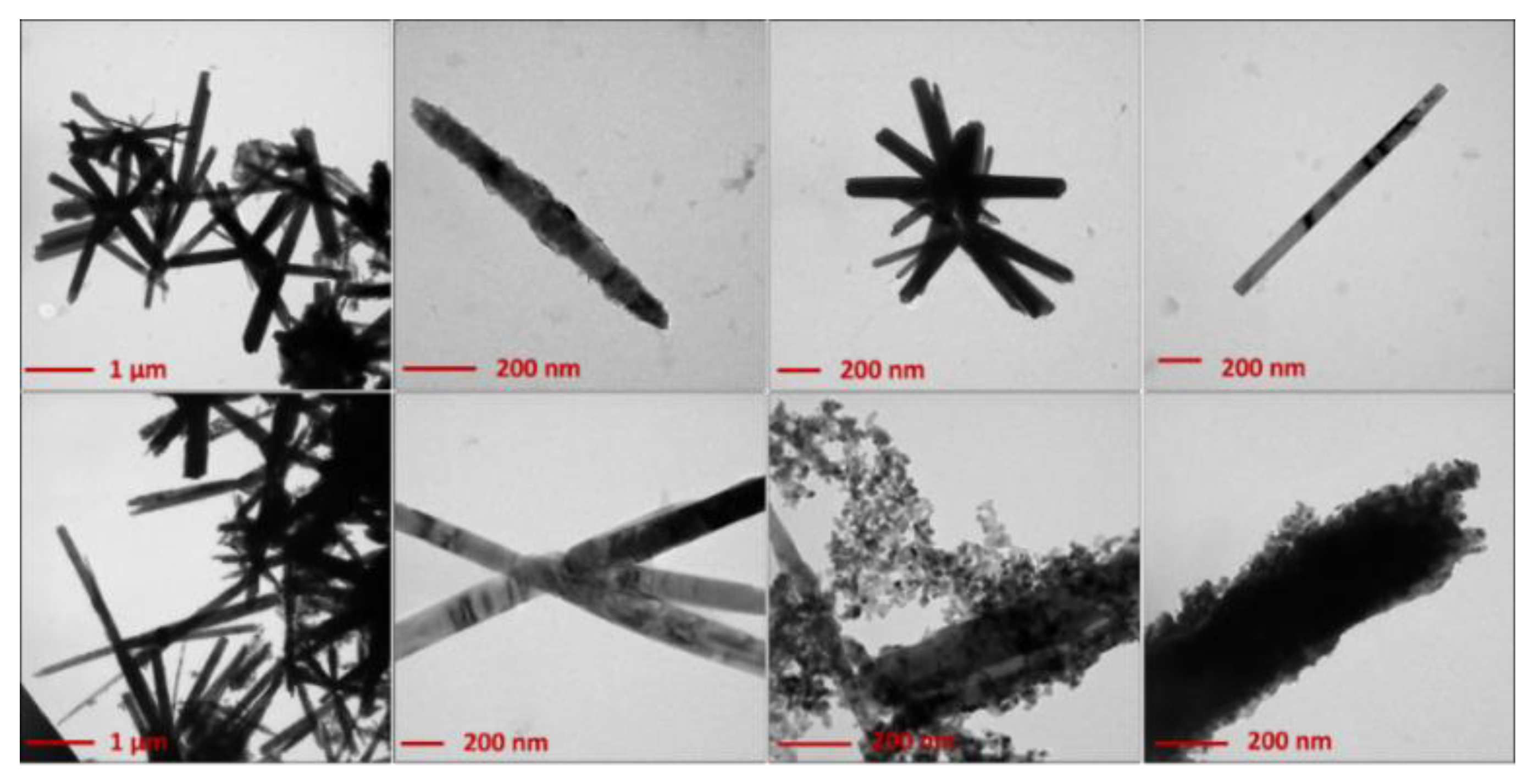
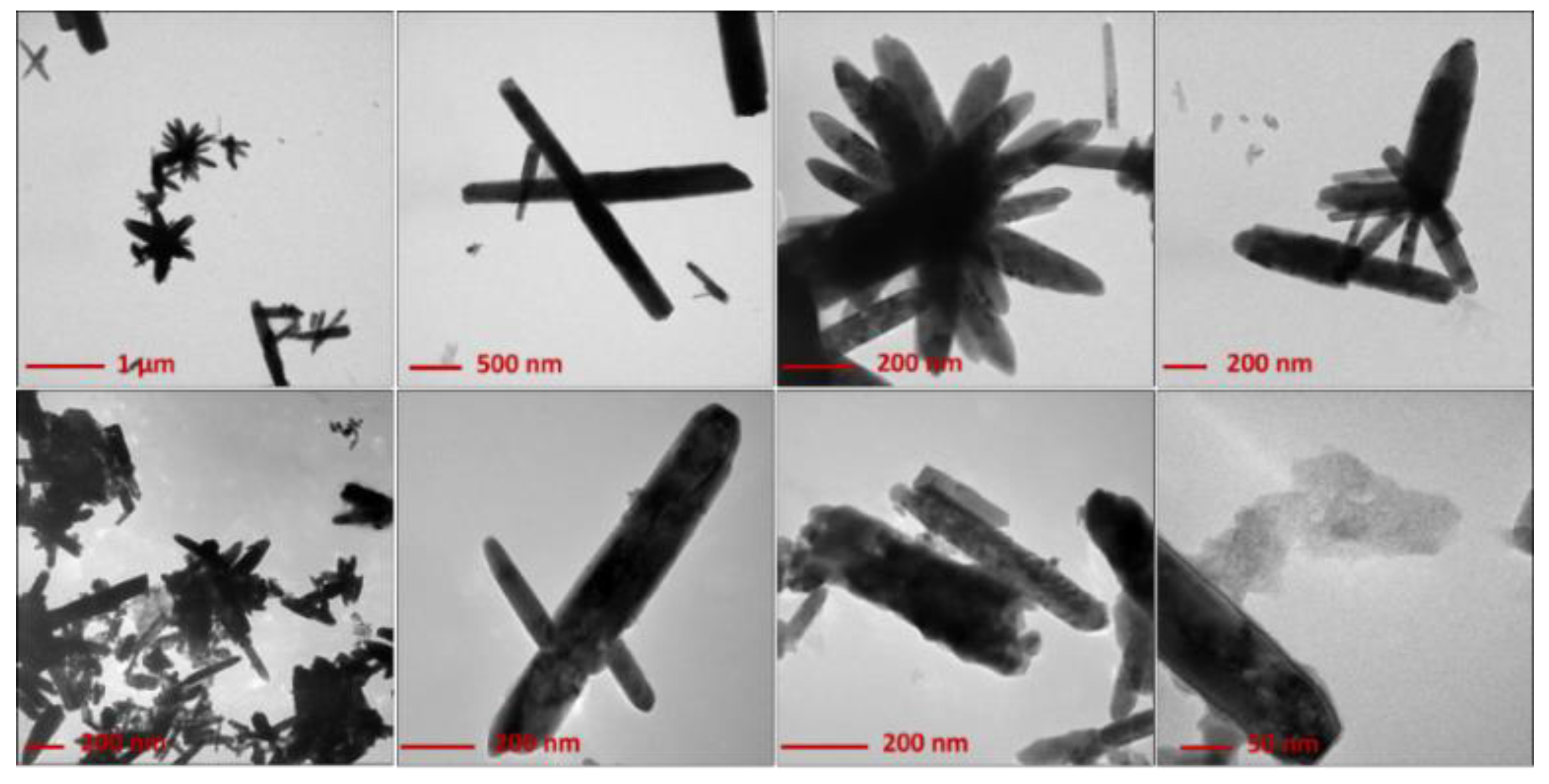
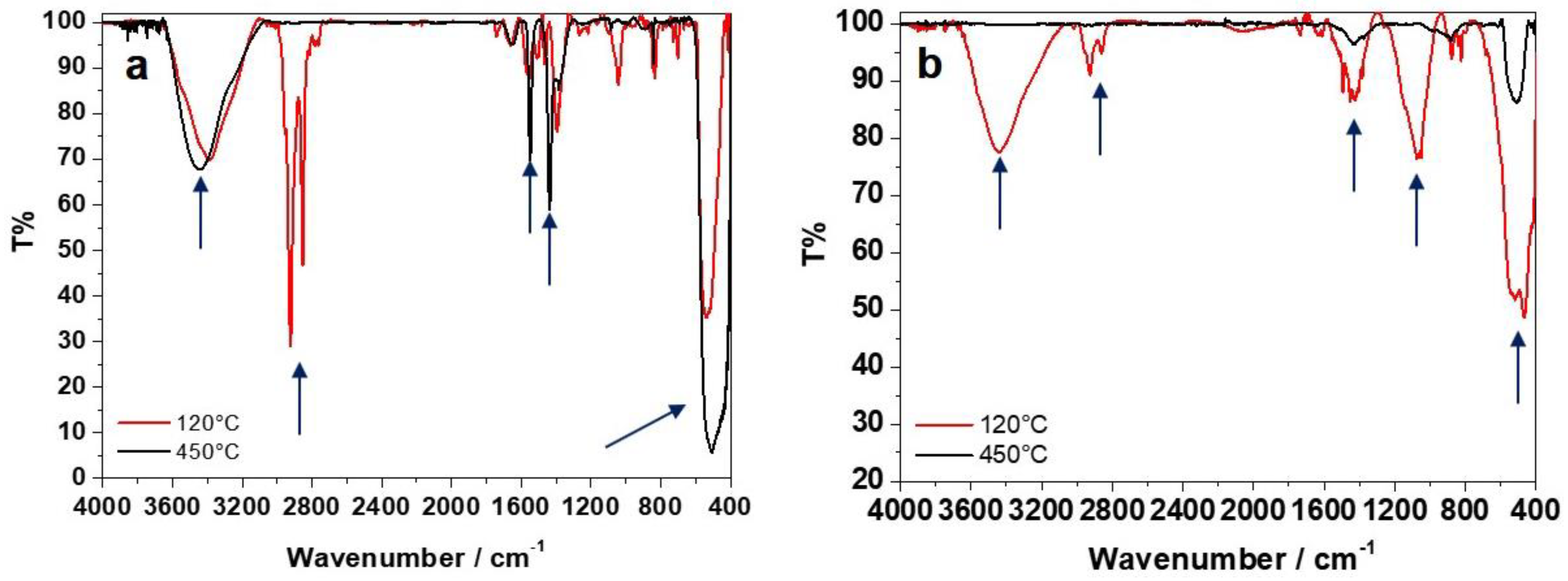
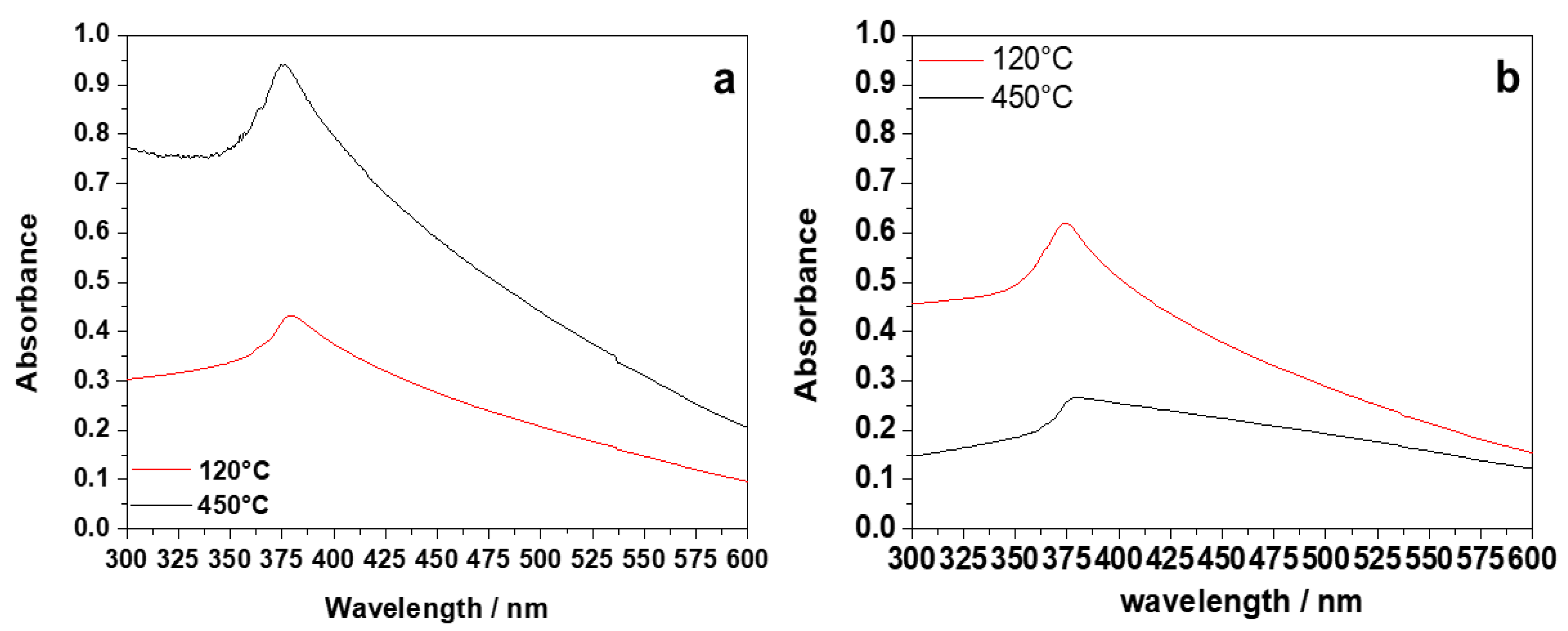
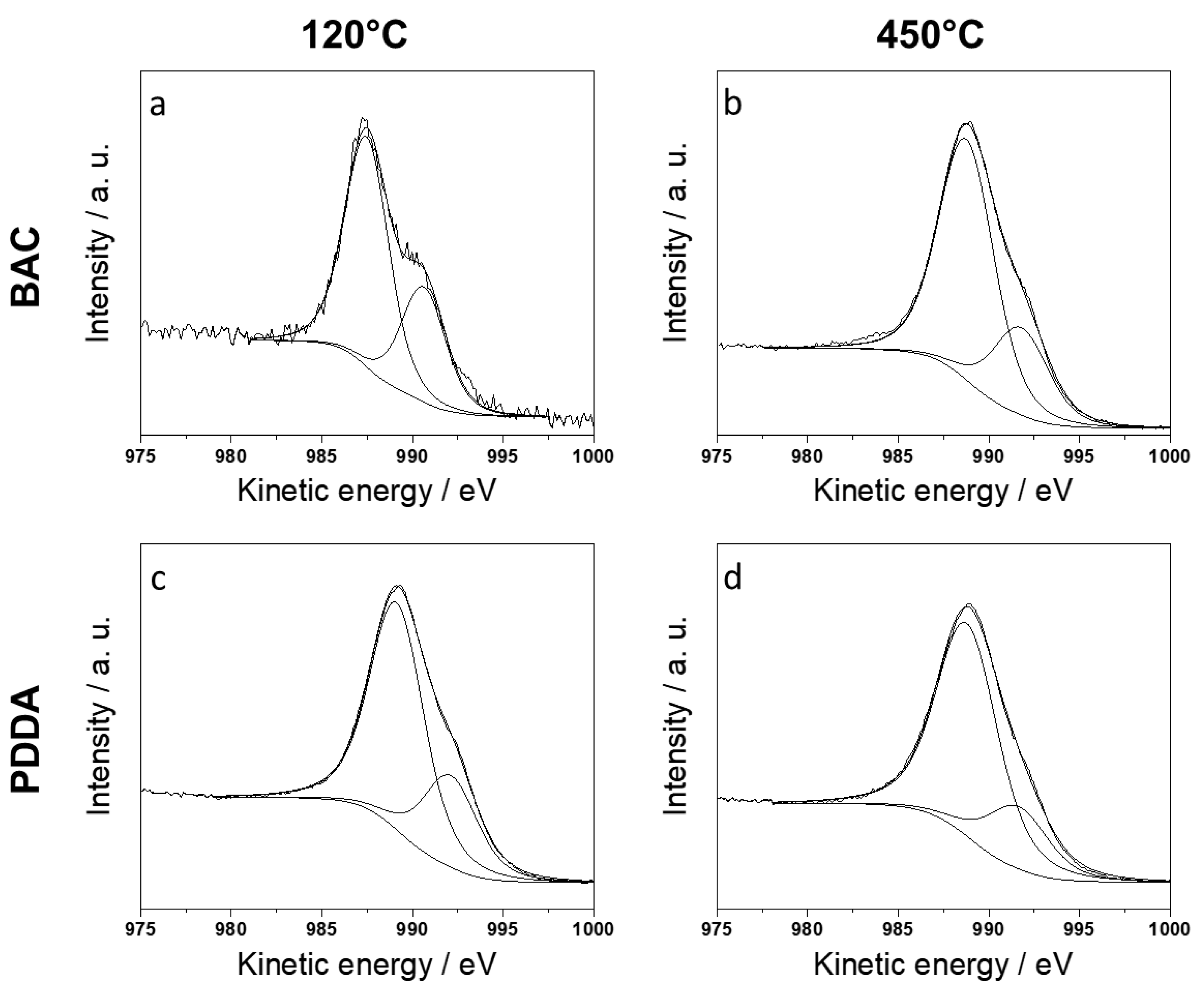
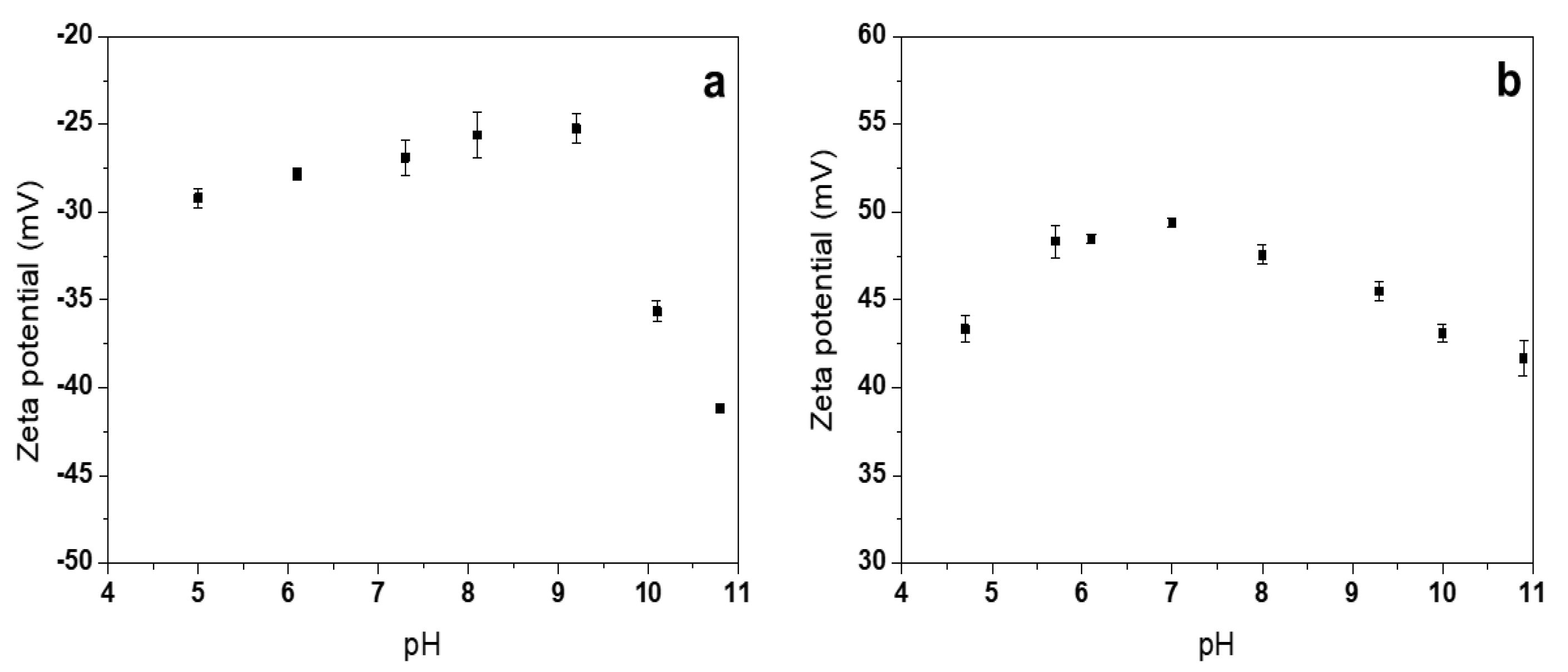

| Stabilizer | ΔmWE (mg) | ΔmCE (mg) | mexperimental (mg) | mtheoretical (mg) | % Yield |
|---|---|---|---|---|---|
| BAC | 19 ± 2 | 0 ± 2 | 19 ± 4 | 24.4 | 79 |
| PDDA | 17 ± 2 | 0 ± 2 | 17 ± 4 | 24.4 | 70 |
| Thermal Treatment | Zn2p3/2 BE (eV) | ZnL3M4,5M4,5 KE (eV) | α′ (eV) | |
|---|---|---|---|---|
| BAC | 120 °C | 1022.0 ± 0.2 | 987.4 ± 0.2 | 2009.4 ± 0.3 |
| 450 °C | 1021.3 ± 0.2 | 988.8 ± 0.2 | 2010.1 ± 0.3 | |
| PDDA | 120 °C | 1021.1 ± 0.2 | 987.9 ± 0.2 | 2010.0 ± 0.3 |
| 450 °C | 1021.2 ± 0.2 | 988.8 ± 0.2 | 2010.0 ± 0.3 |
© 2020 by the authors. Licensee MDPI, Basel, Switzerland. This article is an open access article distributed under the terms and conditions of the Creative Commons Attribution (CC BY) license (http://creativecommons.org/licenses/by/4.0/).
Share and Cite
Sportelli, M.C.; Picca, R.A.; Izzi, M.; Palazzo, G.; Gristina, R.; Innocenti, M.; Torsi, L.; Cioffi, N. ZnO Nanostructures with Antibacterial Properties Prepared by a Green Electrochemical-Thermal Approach. Nanomaterials 2020, 10, 473. https://doi.org/10.3390/nano10030473
Sportelli MC, Picca RA, Izzi M, Palazzo G, Gristina R, Innocenti M, Torsi L, Cioffi N. ZnO Nanostructures with Antibacterial Properties Prepared by a Green Electrochemical-Thermal Approach. Nanomaterials. 2020; 10(3):473. https://doi.org/10.3390/nano10030473
Chicago/Turabian StyleSportelli, Maria Chiara, Rosaria Anna Picca, Margherita Izzi, Gerardo Palazzo, Roberto Gristina, Massimo Innocenti, Luisa Torsi, and Nicola Cioffi. 2020. "ZnO Nanostructures with Antibacterial Properties Prepared by a Green Electrochemical-Thermal Approach" Nanomaterials 10, no. 3: 473. https://doi.org/10.3390/nano10030473









